
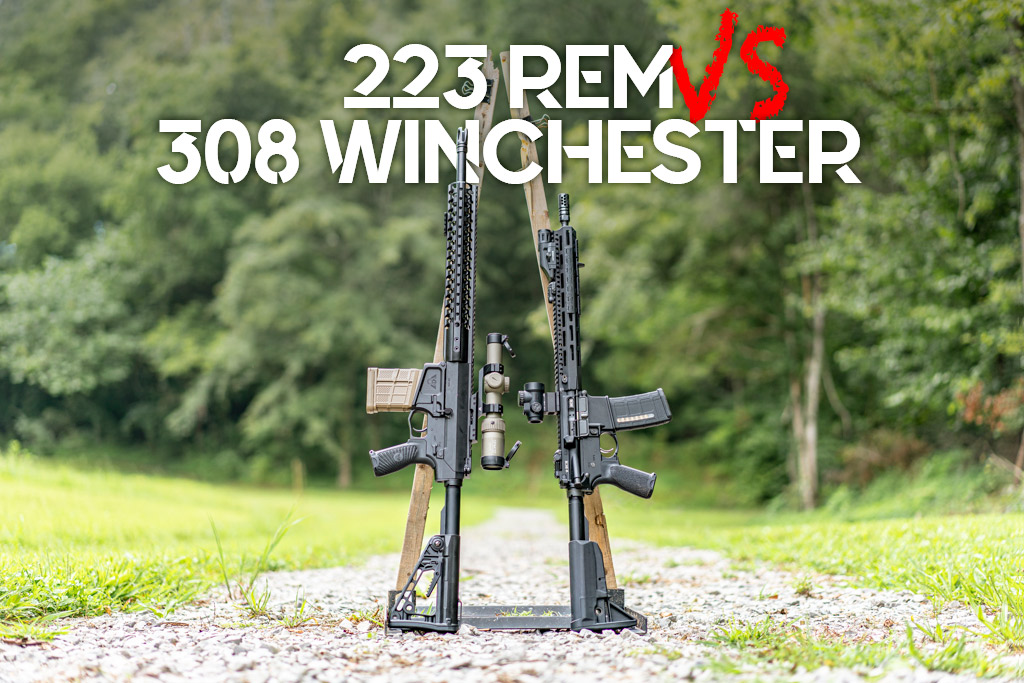
Like kudzu growing in the south, no matter where you go, you can find 223 and 308 ammunition. Some people stack ball ammo by the case, while others prefer boutique offerings in fancy boxes. The point is, that these two calibers remain the most popular centerfire ammo in the civilian and military markets. However, comparing 223 VS 308 can be difficult.
Part of the issue is that both calibers were designed for different military purposes. The .308 Win was designed in the 1950’s for the U.S. Military in hopes of finding a cartridge to replace the .30-06 in their battle rifles. The .223 Rem was designed later in 1962 as a companion cartridge for the smaller caliber, but higher capacity Armalite AR-15 rifle. Both calibers saw battlefield action in their respective service weapons, but not without a fair amount of debate over which one performed the best.
If you’re new to the topic, you may not yet know the technical and practical differences between the 223 VS 308 Winchester. Perhaps you’ve only heard off-handed remarks, like “the 223 is more efficient” or “the 308 has better ballistics.” Whatever you’ve heard, this article will take a middle-of-the-road approach to look at both calibers objectively.
We’ll organize the facts, allowing you to decide which cartridge is right for you. We will talk pros, cons, differences, and similarities. By the end, you’ll know whether the 223 VS 308 is best for you.
223 VS 308 Winchester Compared
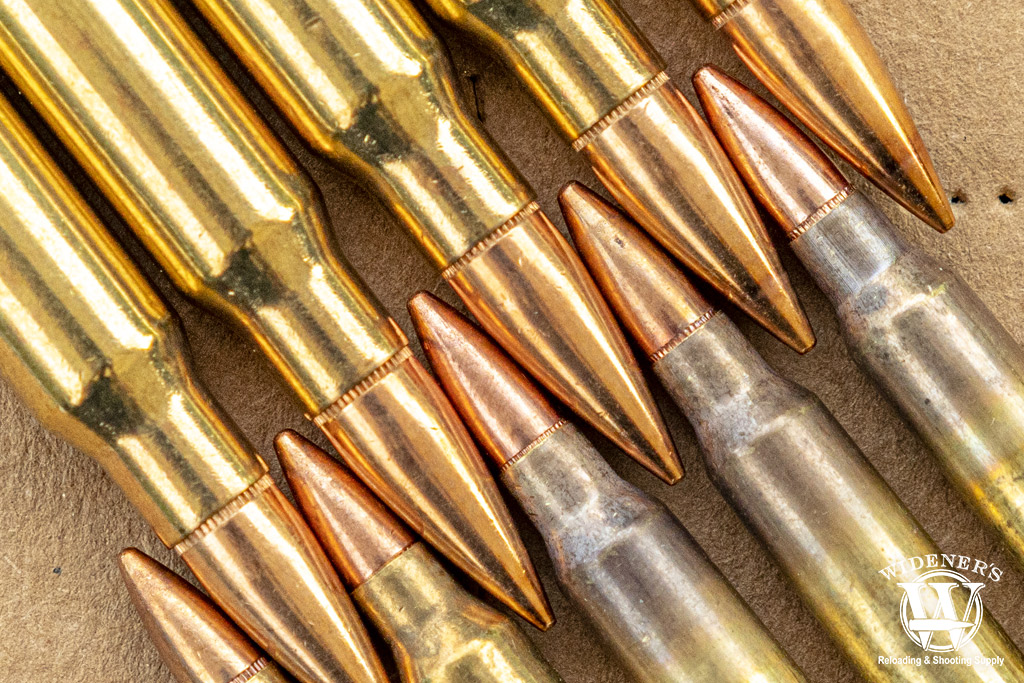
The .308 Win (Top) has more energy and power, while the .223 Rem (Bottom) has more velocity and less recoil.
When talking about the 223 vs. the 308, there are more differences than similarities, which is one reason they are difficult to accurately compare.
Here’s a quick look at some of the main practical differences between the 223 and the 308 (later, we’ll talk about the technical differences):
- Weight
- Price
- Power
- Recoil
Weight: 223 VS 308
The 308 uses a .30 caliber diameter bullet, whereas the 223 uses a .20 caliber bullet. As it happens, most 308 bullets are over twice the weight of the 223. Many people prefer the 223 (over the 308) simply because you can carry about twice the ammunition for the same weight. Standard AR-15 magazines carry 30-rounds of 223, while standard AR-10 magazines carry 10 to 20-rounds of 308 Win. This isn’t a huge difference-maker in all scenarios. However, the fact remains that you can carry more ammo with the .223 Rem. Depending on your objectives, it’s something to consider.
Price: 223 VS 308
You occasionally see .223 caliber gun owners picking up their brass at the range, it’s rare to see .308 gun owners leaving any brass behind. Similar to weight, 308 Win ammo costs (on average) about twice as much as 223 Rem per round. If you reload your own ammo, there are cost savings to be found with both calibers. However, the .308 Win option is still going to be more expensive. This can certainly play a factor if you’re looking to stockpile ammo, or if you just like to go shooting at the range. The .308 cartridge offers more power, but you’re going to have to pay for it.
Power: 223 VS 308
The .308 Win is more powerful than the 223 Rem. The 150gr .308 Win bullet has a velocity of 2,820 and energy of 2,648 Ft Lbs at the muzzle. In comparison, a 55gr .223 Rem bullet has a velocity of 3,240 FPS and energy of 1,282 FT LBS of energy at the muzzle. What does that mean? The .308 can hit targets harder, at further distances, with a greater potential for critical damage than the .223 Rem.
While the 223 can harvest some small to medium-sized game, the 308 is more proficient for taking medium to large-game. With good shot placement, many hunters have no problems using 308 cartridges for taking elk or even black bears. On the other hand, if you shot a bear at a distance with 223, you’d have a very angry bear.
On the self-defense side, having more ammo can be a great advantage. Weapons chambered in .223 Rem make a great argument for self-defense weapons against multiple attackers. The .223 cartridge has impressive performance from muzzle-200 yards, and is still deadly at 300-yards and beyond. However, no one argues that once you get out past the 300-yard mark, the 223 loses a lot of energy – while the 308 is just getting started. There’s a reason the U.S. Military built a sniper rifle platform around the .308 cartridge.
Recoil: 223 VS 308
At face value, the 223 has significantly less recoil than the 308. If you’re new to shooting, you’re going to be a lot more comfortable firing a rifle chambered in 223 VS 308 Win. However, the 308 isn’t known to kick that hard, especially compared to larger calibers. A lot of it depends on the rifle and the load you’re shooting. For example, a well-balanced AR-10 battle rifle is going to have a lot less perceived recoil, than a cheap bolt-action hunting rifle. The same can be said about different rifles chambered in 223.
Note: Keep in mind the term “perceived recoil.” This term sheds light on the fact that recoil isn’t just about the round’s power. Rather, recoil depends on the rifle, the action, and the shooter’s personal stance and tolerance.
Similarities Between The Cartridges
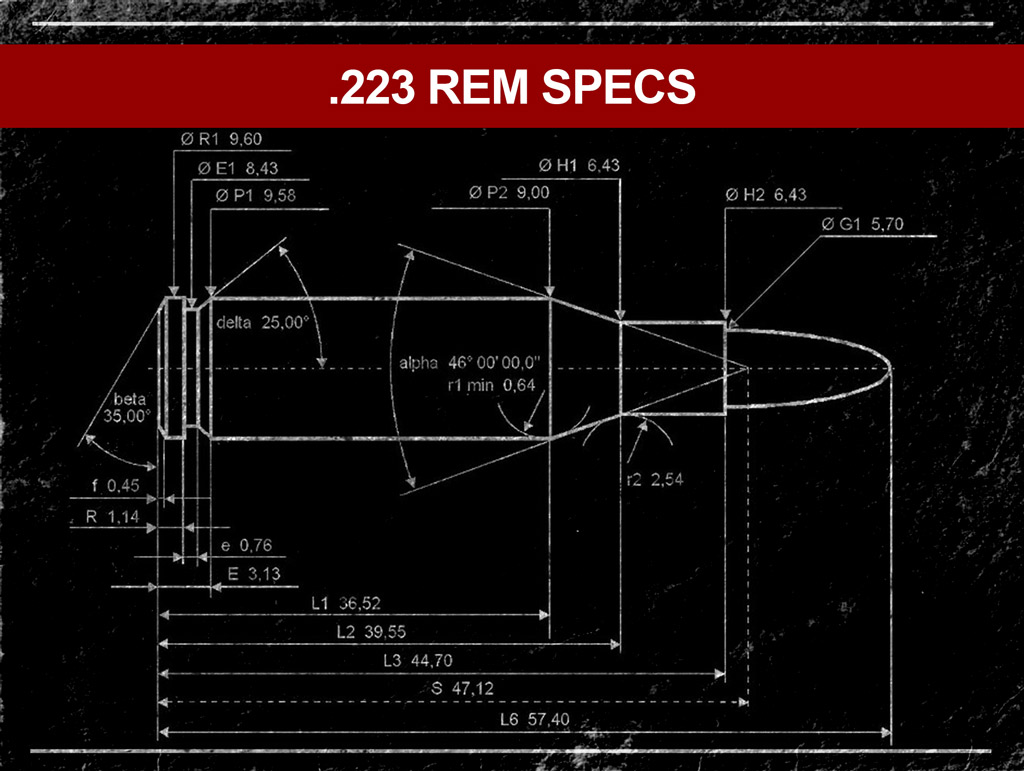
The .223 Rem cartridge is a screamer capable of reaching velocities of up to 4,000 FPS.
While these rounds have many differences on an individual level, they share similarities on a broader scale. If we zoom out, we’ll see that the 223 and 308 share several prominent attributes.
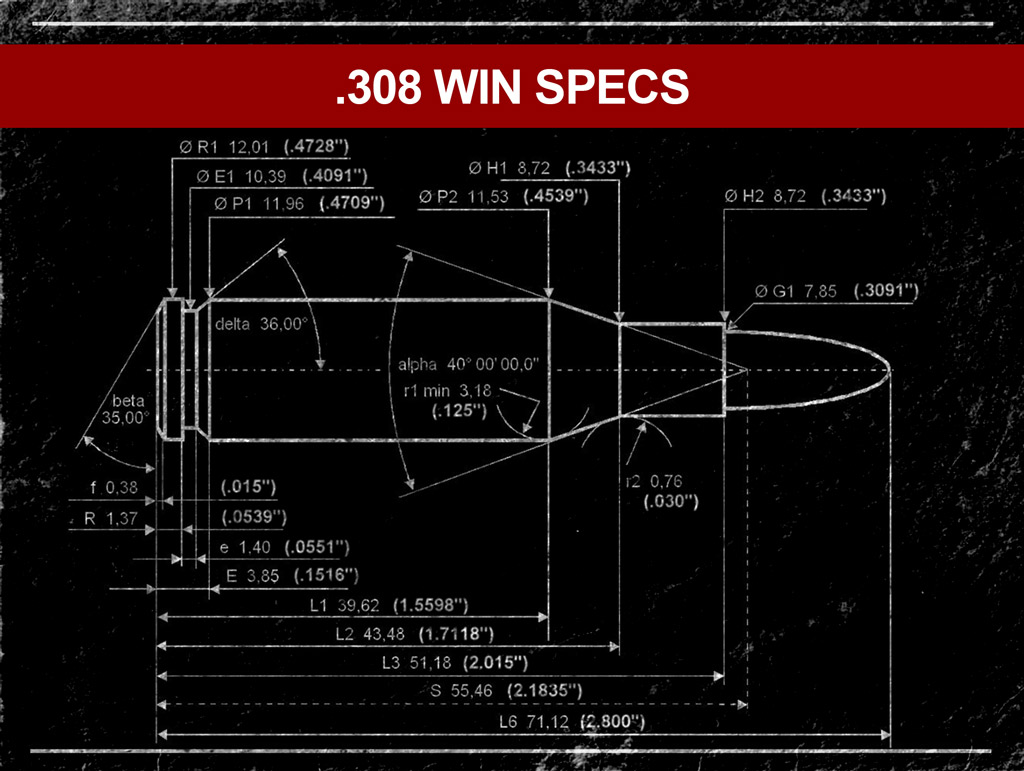
The .308 Win design is a good balance of size, and weight, capable of reaching velocities up to 3,500 FPS.
Similarities between the 223 and the 308:
- Popularity
- Versatility
- Accuracy
Popularity Considerations
The 223 and the 308 have military twins (see the 5.56×45 and 7.62×51 below) that have received widespread acclaim. With that said, the civilian market is also huge for the 308 and the 223, with the 223 being in the running for the most popular cartridge. It’s not hard to see why, with the explosion in popularity of the AR-15 rifle platform in the civilian market.
Sure, sometimes it’s cool to be different. However, with firearms, being part of the “mainstream” has legitimate perks. Ammunition for both calibers is widely available, surplus options can be found, and buying in bulk can actually save you money. Customizations and aftermarket rifle accessories for the AR and bolt-action markets are abundant to the point of redundancy. With the popularity, if you have a question, there’s likely someone online with a quick answer.
That said, newer rounds like the 6.5 Creedmoor and 6.5 Grendel are doing some neat things as well.
Versatility Considerations
Versatility goes along with popularity. Of course, when comparing 223 VS 308 they both have limitations. However, within their prospective classes, there are nearly unlimited options for firearms and ammunition. Depending on your mission, there’s a firearm chambered in the caliber you need to complete it. Depending on your budget, there’s an accessory in production to improve your weapon’s performance. No matter how specific your need, there’s also likely a cartridge and bullet type out there to handle it.
From break-action to bolt-action, to semi-automatic or full, there’s a rifle type out there with the capabilities you require. Not only that, but, there’s a sliding scale for caliber compatibility within the different platforms. The AR-15 platform can be chambered in calibers ranging from .223 Rem to .458 SOCOM. While the AR-10 platform can handle anything from .308 Win to .338 Fed on its beefy chassis. Many accessories are compatible between calibers, so users are able to benefit from choosing either one of these versatile options.
Accuracy Considerations
The 223 and the 308 are known to be precise centerfire rounds. Their design is such that the flight path of the bullet stays true to where you point it. Bullets do not travel in a straight line, but rather, have an arching flight path. Wind and gravity impact the accuracy of any caliber bullet, so in theory, higher velocity calibers should have more consistent accuracy. That being said, the accuracy of the .223 Rem and .308 Win is equal to about 300 yards. At distances greater than 300-yards, the .223 is less accurate than the .308, despite it having a higher average velocity.
The reason for the decrease in accuracy is the loss of energy and the weight of the bullet. The light-weight .223 Rem bullet loses velocity much faster, reducing its energy, and affecting its accuracy at distances. Although heavier, the .308 Win bullet retains more of its energy and is less affected by wind and gravity giving it better accuracy at greater distances. At 500-yards, the .308 Win bullet retains more than twice the amount of energy as the .223 Rem, while nearly matching it in velocity. As mentioned, the .308 Win has long been a popular sniper rifle caliber, while the .223 Rem is more common for landowners trying to take down small critters over large fields.
Cartridge Size Comparison
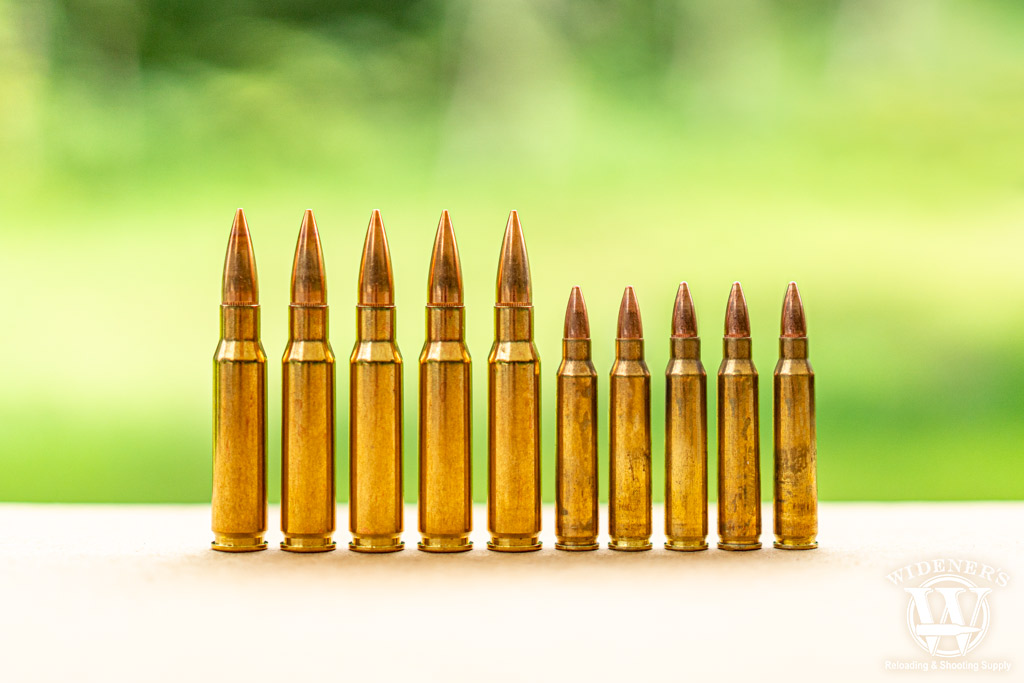
The .308 Win (Left) is roughly twice the size and weight of the .223 Rem (right).
The 308 is larger in every way. It’s longer, wider, and fires a .30 caliber bullet. As you’ll see, this presents an unfair power comparison, particularly when shooting beyond 300 yards. However, effectiveness is not all about power. Recoil, weight, accuracy, and of course, intended purpose all play a factor.
As dad used to say on Christmas morning, sometimes the best things come in small packages.
With that, here are a few detailed specs on the size of the 223 vs. the 308:
| Cartridge Specs | .223 Rem | .308 Win |
|---|---|---|
| Parent Casing | .222 Remington | .300 Savage |
| Bullet Diameter | .224″ | .308″ |
| Neck Diameter | .253″ | .3433″ |
| Base Diameter | .376″ | .4709″ |
| Case Length | 1.76″ | 2.015″ |
| Overall Length | 2.26″ | 2.8″ |
| Grain Weight | 36gr-77gr | 110gr-180gr |
| Max Pressure (SAMMI) | 55,000 PSI | 62,000 PSI |
You’ll see some pressure variation between the NATO counterparts (5.56 and 7.62). See our section on that below.
223 VS 308: Ballistic Comparison
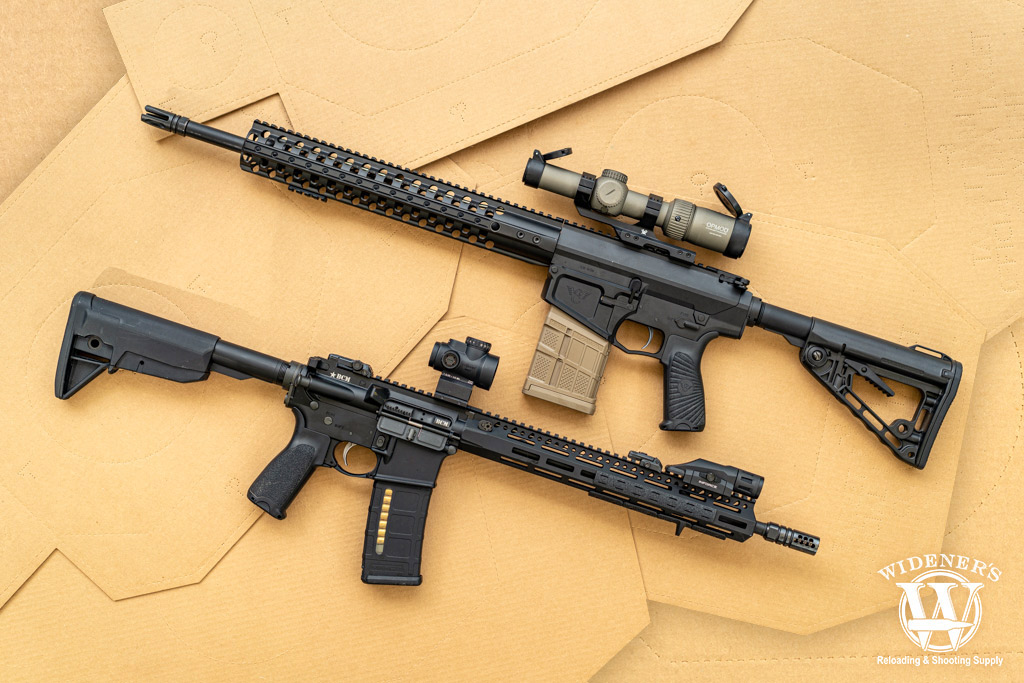
AR-15 VS AR-10: Size matters, but how well you can shoot, reload and control the rifle matters as well.
As you’ll see, these ballistics reflect the common talking points among those showing support for each round. In the group that owns firearms for defense, the 223 is the round of choice for close-range combat, including urban operations and home defense.
On the other side of the aisle, the 308 is the round for long-distance engagements and immediate stopping-power. We really start to see the effects of the larger 308 at longer ranges. The 308 carries over 1000 ft-lbs. of energy past 500 yards. The heavier bullet has also been tagged as more practical for “the bush,” where it’s less affected by brush and branches.
Here are some specifics comparing the ballistics of the 308 and the 223:
| Caliber | Bullet Type | Bullet Weight | Velocity (Muzzle) | Energy (Muzzle) | 100 Yards (Velocity/Energy) | 200 Yards (Velocity/Energy) | 300 Yards (Velocity/Energy) |
|---|---|---|---|---|---|---|---|
| .223 Rem | FMJ | 55gr | 3,240 FPS | 1,282 FT LBS | 2,874 FPS/1,008 FT LBS | 2,536 FPS/785 FT LBS | 2,222 FPS/603 FT LBS |
| .308 Win | FMJ | 150gr | 2,820 FPS | 2,648 FT LBS | 2,597 FPS/2,246 FT LBS | 2,385 FPS/1,894 FT LBS | 2,183 FPS/1,586 FT LBS |
Caliber Specific Uses
Comparing these two rounds is like comparing the performance of two muscle cars. Sure, a Camaro might beat a Mustang off the line, but who crosses the finish line first depends on a multitude of factors – the engine, the tires, the weather, the road, and of course: the driver.
If you’re primarily a hunter, you might find the 308 fits more tasks – especially if you have large-game in your future. Sure, you can drop deer with quality .223 hunting ammo and a well-placed shot. There are plenty of white-tail bucks that have been harvested with the smaller cartridge. But why work harder? The .30 caliber .308 cartridge makes a larger wound channel and hits soft targets with a lot more disruptive energy. Meaning, that you’re more likely to bring a deer home, rather than to spend your time tracking blood trails in the woods.
However, just because a round hits harder, doesn’t mean that it’s the best for every job. For those who might be hunting small game for food or coyote hunting for pelts, the 308 is just too much power. The same could be said about using the 308 for home defense. Without question, it will get the job done, however, you also run the risk of overpenetration. The 223 offers several more well-suited solutions for home defense. For example, Hornady’s .223 55gr FTX Critical Defense bullet. Its polymer tip is designed to pass through clothing, expanding quickly and slowing the bullet down as it loses its velocity.
The Other Guys: 5.56 NATO VS 7.62×51 NATO
Let’s quickly chat about the NATO counterparts to the 223 VS 308 rounds.
The 5.56×45 and the 7.62 are popular NATO rounds, known as the 5.56 NATO and the 7.62×51 NATO respectively. At first glance, they look just like regular 223 and 308 rounds. Ultimately, the main difference between them is in the pressure generated, and the rifles that can safely chamber them.
Starting with the 308 and 7.62 NATO, here’s what you need to know. The .308 Win cartridge can handle pressure up to an impressive 62,000 PSI, while the 7.62 taps out at around 60,000 PSI. Generally, 308 chambered rifles can fire both 308 rounds and 7.62 NATO rounds without issue. However, 7.62 rifles should generally only fire 7.62 NATO rounds because of the difference in chamber size and cartridge pressure (there is some variance here, so check with your manufacturer).
For the 223 and the 5.56 NATO, this principle is reversed. You can fire both 223 and 5.56 from a 5.56 chamber, but it’s not advised to fire a 5.56 through a 223 chamber. Again, the reasoning is due to a difference in pressures and chamber size. The .223 Rem and 5.56 NATO cartridges can handle pressure up to 55,000 PSI but 5.56 ammo may be loaded to higher pressures, and 5.56 chambers are manufactured with dimensions to better handle it.
Key Takeaways: 223 VS 308 Winchester

The .223 Rem is the best all-around cartridge, but it lacks the power of the .308 Win for hunting and shooting long distances.
Personality and individual philosophy guide people in their choices. Many of these decisions come from rational deduction, but they also spring from different personal experiences. There’s nothing wrong with that. For a large majority of gun owners, the .223 Rem checks every box on their needs list. It’s a versatile, low recoil cartridge that performs well in a variety of categories. Including range training, small-medium game hunting, varmint control, and home defense.
For others, size is an important factor in their decision-making. The .308 Win delivers optimal ballistic performance at distances, without the recoil of larger calibers. While it is more expensive than the .223 Rem cartridge, you can buy bulk surplus for the range, which is much cheaper than the boutique options. For medium-large game hunters, the ethical choice is clear. The .308 Win is much more powerful with plenty of ammo options for putting meat on the table.
Looking for the best 223 VS 308 ammo? Be sure to read our article on the best 223 ammunition. Or, check out our guide to the best .308 rounds.


